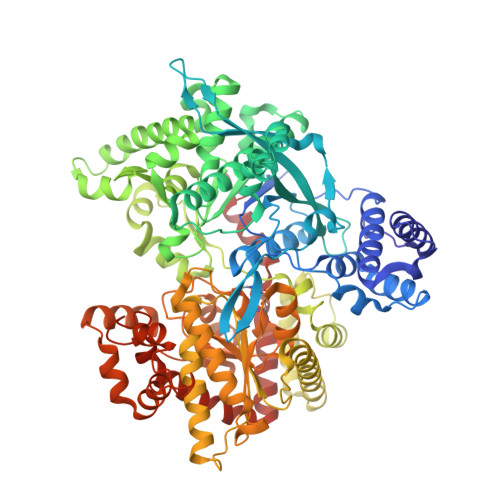Conformational and Electronic Variations in 1,2- and 1,5a-Cyclophellitols and their Impact on Retaining alpha-Glucosidase Inhibition.
Ofman, T.P., Heming, J.J.A., Nin-Hill, A., Kullmer, F., Moran, E., Bennett, M., Steneker, R., Klein, A.M., Ruijgrok, G., Kok, K., Armstrong, Z.W.B., Aerts, J.M.F.G., van der Marel, G.A., Rovira, C., Davies, G.J., Artola, M., Codee, J.D.C., Overkleeft, H.S.(2024) Chemistry 30: e202400723-e202400723
- PubMed: 38623783
- DOI: https://doi.org/10.1002/chem.202400723
- Primary Citation of Related Structures:
8RVK, 8RW3 - PubMed Abstract:
Glycoside hydrolases (glycosidases) take part in myriad biological processes and are important therapeutic targets. Competitive and mechanism-based inhibitors are useful tools to dissect their biological role and comprise a good starting point for drug discovery. The natural product, cyclophellitol, a mechanism-based, covalent and irreversible retaining ¦Â-glucosidase inhibitor has inspired the design of diverse ¦Á- and ¦Â-glycosidase inhibitor and activity-based probe scaffolds. Here, we sought to deepen our understanding of the structural and functional requirements of cyclophellitol-type compounds for effective human ¦Á-glucosidase inhibition. We synthesized a comprehensive set of ¦Á-configured 1,2- and 1,5a-cyclophellitol analogues bearing a variety of electrophilic traps. The inhibitory potency of these compounds was assessed towards both lysosomal and ER retaining ¦Á-glucosidases. These studies revealed the 1,5a-cyclophellitols to be the most potent retaining ¦Á-glucosidase inhibitors, with the nature of the electrophile determining inhibitory mode of action (covalent or non-covalent). DFT calculations support the ability of the 1,5a-cyclophellitols, but not the 1,2-congeners, to adopt conformations that mimic either the Michaelis complex or transition state of ¦Á-glucosidases.
Organizational Affiliation:
Leiden Institute of Chemistry, Leiden University, Einsteinweg 55, 2333 CC, Leiden, The Netherlands.



















